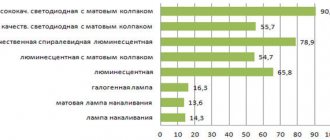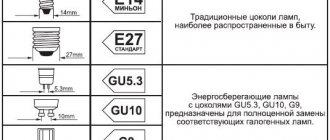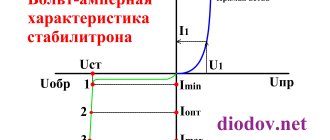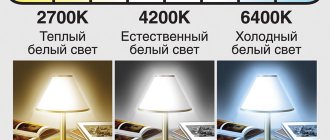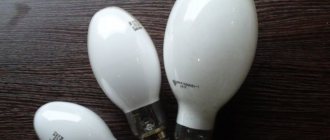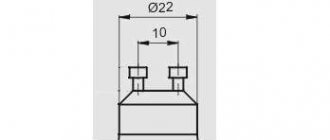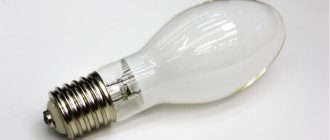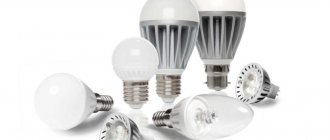What is the angle of light scattering, and what is it like?
The light scattering angle is the angle within which the light rays diverge from the lamp. Therefore, it is also called divergence angle and viewing angle.
Roughly, light scattering angles can be divided into three groups:
- Narrow viewing angle – 30-45°. This is a concentrated narrow beam of light that illuminates a small area;
- The average angle is 60-90°. Wider divergence of the light beam, suitable for a local area if the lamp is single, or for general illumination if the lamps are installed in a group;
- Wide divergence angle – 120-180°. Such lamps are used to create general light.
The ability to choose the backlight with the desired scattering angle is an absolute plus of LED lamps, in contrast to the same incandescent lamps, which provide light with a divergence angle of 360°. To obtain the desired scattering angle, LED lamp manufacturers use different types of bulbs, reflectors, focusing or diffusing lenses, and also position the LEDs inside the light source in a special way.
For example, a lamp will provide narrowly focused lighting if the LEDs in it are located on the same plane, or diffuse lighting if the LEDs are arranged in a multi-level manner.
Main technical characteristics
When choosing LED lamps, first of all, look at the base: if it differs from the chandelier socket, it will be impossible to install a new lamp in place of the old one.
In lighting fixtures used in apartments, the most common types of base are:
- E27 (standard), which is most common;
- E14 (minion), smaller than standard diameter, often used in pendant lamps.
The sockets, marked with the letter G, have a low power (12 W) and, depending on the type, are used for spotlights or built-in lamps, kitchen hoods and other electrical appliances.
Power
This indicator primarily affects not the brightness of the lamp, like incandescent lamps, but the energy consumption: the lower the value, the more economical the lighting.
Modern LED lamps consume approximately 5 times less electricity than incandescent lamps producing the same amount of light. To make sure of this and choose a lamp suitable for power, it is worth studying the table.
You can maintain the usual level of lighting in your apartment or house by choosing light bulbs with a power of about 10–15 W. Such devices provide sufficient light for work and rest. Sconces and table lamps will require lower wattage lamps.
Brightness
Luminous flux is an indicator of the amount of light emitted by a LED lamp. Measured in lumens.
For residential premises in an apartment or house, there is no point in purchasing lamps with an efficiency higher than 130 lm - products with higher performance will cost significantly more, and the difference in lighting will be practically unnoticeable.
It will be easier to understand how to choose the right LED lamp for the desired brightness level if you study the table, which presents the comparative characteristics of different types of light sources.
Unscrupulous manufacturers often overestimate indicators, so the actual amount of light produced may be almost 30% less than that stated on the product packaging. In order not to make mistakes in your calculations, you should purchase products only from well-established companies.
Important! A frosted bulb can reduce the level of luminous flux by almost a third.
When choosing a lamp for a room that needs good lighting, you need to take this fact into account.
Colorful temperature
How to choose an LED lamp for your home that will emit the familiar warm light emanating from an incandescent lamp. To do this, you need to pay attention to the color temperature of the lamp.
It is indicated directly on the packaging, measured in degrees Kelvin and gives an idea of what the emitted light will be like - the higher the value, the cooler it is:
- Products with values below 2500 K are not recommended for use in residential premises. They produce a heavy yellow light that creates an uncomfortable environment.
- To illuminate a house or apartment, you should choose lamps whose color temperature is 2700–3000 K; they produce the usual yellowish light.
- Daylight - from 3000 to 5000 K - is used to illuminate industrial, office and public premises, but does not create a comfortable atmosphere in residential ones.
- Bulbs with a color temperature above 5000 K emit blue-white, cool light. Ophthalmologists do not recommend staying in rooms illuminated by such devices for long periods of time.
Some manufacturers do not indicate the color temperature in degrees Kelvin, but give a brief description of the type of light. For a house or apartment, light bulbs with the designations “soft white” and “warm white” are suitable on the packaging.
Color rendering index
Color rendering index is an indicator of the correspondence of the lighting created by a lamp to daylight.
Lamps with a color rendering index above 70 are considered good, and those with this parameter below 40 are not worth purchasing.
Important! High-quality products with a high color rendering index cannot be cheap. If the packaging of an inexpensive lamp has a value above 80, it is almost certainly a fake.
Light angle of the lamp - specific examples
Let's look at how to choose a lamp with a certain angle of light for different lighting using the example of LeDron lamps.
- Narrowly focused lighting. Such lighting is used to brightly illuminate a selected functional area - for example, a cooking area in the kitchen, shelves with clothes in the dressing room, a work desk. An example is the LeDron CSU0809 BLACK surface-mounted LED lamp. The light angle of the lamp is 32°;
- Intermediate lighting. Devices with this indicator can either illuminate a specific area - the dining room, bedside tables, the area near the mirror in the hallway, or be used as part of the overall lighting system. A good example of such a model is the recessed rotating lamp LeDron LB13 White with a dispersion angle of 60° and a rotating option;
- General light. For uniform illumination of the interior, the overhead LED lamp SDL06-R80-4200K is suitable. It has a viewing angle of 120° and can well illuminate a small room - including a bathroom, due to its IP dust and moisture protection class
You can choose a lamp with the desired angle of light on our website yourself or with the help of LeDron specialists. Contact us for a consultation!
Review of LED lamps: popular manufacturers and cost of lamps
It will be easier to choose high-quality LED lamps if you study the list of the most frequently purchased products, assessing the advantages and disadvantages of each.
LED lamps, according to manufacturers, can serve regularly for up to 25 years. Long service life, product quality stated on the packaging, luminous flux and color rendering index are provided by well-established manufacturers on the market:
- General Electric (USA);
- Osram (Germany);
- Philips (Holland);
- CREE (USA);
- BLV (Germany);
- SUPRA (Japan);
- NICHIA (Japan).
The minimum cost of lamps from these manufacturers is 300 rubles.
Trustworthy domestic companies:
- Start;
- Optogan;
- Gauss;
- Kreonix.
The price of products starts from 150 rubles.
On the market you can find other LED lamps for the home from unknown brands and Chinese companies at a price significantly lower than the average. However, it is unwise to purchase such products - such savings will not justify themselves: there are no guarantees that the lamp will last a long time. In addition, due to low-quality materials and non-compliance with production standards, such products may be environmentally unsafe.
Choosing LED lamps is an activity that requires care and a thorough approach. However, the long service life and proper operation of the purchased devices will allow you to forget about the problem of lighting an apartment or house for at least 5 years - this is exactly the warranty period that manufacturers give for their products.
Colorful temperature
Color temperature is an indicator that indicates the shade of the emitted light flux. Conventionally, all lamps are divided into three types:
- With warm color temperature.
- With neutral color rendering indicators.
- With cold light.
Types of color rendering.
When choosing lighting fixtures, take into account the place in which they will be used. If this is a bedroom, it is better to give preference to warm or white lighting (up to 3000 K). In the kitchen and bathroom it is better to use lamps with neutral lighting (3500 K). If commercial objects are illuminated, then it is advisable to choose cool lighting. Equipment that creates the effect of daylight (more than 5300 K) is not used in residential spaces, only for specific work. Cold light lamps are also used as elements for emergency lighting. Comparison table:
| Parameters of LED lamps, type of lighting, created atmosphere in the room | |||||
| Temperature | Warm light (2700 K) | White lighting (3000K) | Neutral lighting (3500K) | Cold light (4100 K) | Daylight (6000 K) |
| Atmosphere | Warm and cozy atmosphere | Brighter light that creates a pleasant atmosphere with good visibility | Pleasant atmosphere with excellent visibility | Bright and clean atmosphere | Emphasizing colors and too bright atmosphere |
| Where is it used? | Residential premises, cafes and restaurants, boutiques | Shops, offices, libraries | Office premises, exhibition halls, supermarkets, shops | Offices, hospitals and hospitals, large supermarkets, shopping centers, classrooms in schools | Galleries, exhibitions, jewelry outlets, medical offices that are used for examinations |
Light flow
Luminous flux is the amount of energy given off by a lighting element. Knowing the parameter, you can quickly find a replacement for a burnt-out light bulb in lighting equipment. Luminous flux is measured in lumens. The second parameter is efficiency. It determines the ratio of the power of the luminous flux to the power of consumed electricity. These indicators indicate the efficiency of LED devices. For example, a standard incandescent lamp has a power of 20 W. Its luminous flux is equal to 250 lumens. The same light flux indicators are observed in LED bulbs with a power of 2-3 W.
Luminous flux indicators.
Type of room and lighting level
- Bedroom, kitchen – 150 Lx/sq.m
- Children's room - 200 Lx/sq.m
- Bathroom, toilet – 50 Lx/sq.m
- General purpose office using computers - 200-300 Lx/sq.m
- Large office with open plan - 400 Lx/sq.m
- Office where drawing work is carried out - 500 Lux/sq.m.
- Conference room – 200 Lx/sq.m
- Escalators, stairs - 50-100 Lux/sq.m
- Hall, corridor – 50-75 Lx/sq.m
- Archive – 75 Lx/sq.m
- Pantry – 50 Lx/sq.m
Design and features of diodes
Externally, an LED light bulb is not much different from its counterparts - structurally, it also consists of a glass bulb and a base. But the internal content of the soffit has changed dramatically. The role of the illuminator is not performed by a tungsten filament, but by a light emitting diode (LED).
To light an LED, a low voltage is required, so the device is supplemented with a driver - an electronic circuit that converts alternating current.
Each element performs a specific function:
- the working pair of radiator/aluminum board is responsible for cooling and removes heat from the LEDs and power supply;
- The driver, in addition to stabilizing the current, protects the lamp from short circuits and minimizes pulsation of the light flux;
- the system and the number of LEDs determines the power of the light bulb and the angle of illumination;
- The diffuser ensures uniform beam delivery.
The quality of component parts determines the lighting parameters, the durability of LED products and the safety of their operation for human health.
The standard design of a diode lamp, in addition to the diffuser bulb, LED system and base, includes a driver, a radiator and an aluminum printed circuit board
The increased interest in diodes is due to a number of significant advantages relative to incandescent lamps:
- efficiency - electricity consumption is reduced by 8-10 times;
- durability – service life increased by 20-40 times;
- maintaining brightness during voltage surges;
- slight heating of the bulb - there is no risk of getting burned by the LED lamp.
In a lamp of limited power, you can install a brighter diode than an outdated analogue with an incandescent coil.
LEDs also outperform fluorescent lamps in the following parameters: efficiency, safety and glow quality. The spectrum of LED illuminators is closer to daylight
Diode light bulbs still have disadvantages. Main disadvantages: high price and availability of low quality products for sale. In addition, the ability to change brightness is limited - dimming is provided only in more expensive models.
Adjustable LED lamps
LED devices allow you to adjust the brightness of the lighting. This happens with the help of a control device - a dimmer. The regulator helps to obtain the most suitable light that will not strain your eyesight. The dimmer works by generating pulses. Their frequency affects the brightness of the lighting. Not all LED systems can be adjusted using a dimmer. Its functions can be performed by a driver that is built into the lamps. In this case, the functionality will be somewhat limited.
If the buyer needs dimmable equipment, it is worth carefully studying the packaging of the products. All manufacturers write on the boxes about the possibility of adjusting lighting.
Size guide markings
The dimensions of SMD LED housings can be determined by markings. For example, the length and width of SMD 5050 are 5 cm, the dimensions of SMD 3528 are 3.5x2.8 cm.
By marking DIP diodes, you can determine not only the dimensions. For example, for a round product, the marking 5RHWWC3000mcd6500K34V70 means that it is round (RH) with a diameter of 5 mm, the color is cold white (W), the body is transparent (WC), voltage 3.4 V, dispersion angle 70 degrees. The marking of the square DIP 8x8red50mcd2.1V indicates that the length and width are 8 mm, the color is red, the light intensity is 50 mcd, the voltage is 2.1 V.
On LED lamps with screw bases E 14 E 27, the numbers indicate the diameter of the bases. GU 5.3, GU 10 and G 13 are swivel sockets with a two-pin connector. The numbers indicate the distance between them.
Attention! When choosing light bulbs for luminaires with a pin base, sockets with appropriately sized spaces between the pins are required.
There are filament LED lamps with E 27 or E 14 sockets in which the driver is installed. Their sizes and shapes are different, most are similar to ordinary incandescent lamps, the numbers are the diameter of the base.
Glow degradation time
Manufacturers of LED modules and lamps indicate a long service life - from 20 thousand hours (for old models), up to 30-50 thousand hours for new SMDs, up to 100 thousand hours - for the most modern products. For the average consumer, it is important to know whether these numbers can be trusted.
Typically, service life is the period of time during which products stop working, not completely, but until the luminous flux parameters drop to a certain level. Some manufacturers take 30% as a threshold, others – 50%, but neither the technical documentation nor advertising materials indicate this, which prevents you from choosing a model.
Most often, the service life is 50 thousand hours (5 years and 8 months). It is impossible to verify this through testing. Models change very quickly, within 5 years others appear, and the old ones are no longer made. Tests are carried out quickly under extreme conditions.
The degradation time depends on:
- decreased diode performance;
- phosphor aging period;
- mechanical deformations;
- reduction in the characteristics of the primary optics.
The luminous flux is reduced mainly due to crystal degradation as a result of current leakage from the light-emitting areas. Degradation manifests itself as a decrease in voltage. In order for the service life to correspond to the declared one, the lighting device must operate in conditions in which the temperature does not increase. The current must correspond to the value specified by the manufacturer; it is advisable to install a device in the circuit that protects against static electricity. The crystal degrades very quickly if the solder joints are destroyed (there was a defect in production).
When a phosphor ages, it is not the brightness that changes, but the hue of the glow (a blue color appears). The primary optics are made from silicone and plastic. When exposed to ultraviolet light emitted by the LED, these materials become cloudy. The same thing happens when the temperature is too high. The service life is also reduced by a low-quality driver (if its power does not match the power of the diodes) and a decrease in the characteristics of the secondary optics (if any).
Attention! In the documents, manufacturers indicate the period that the LED is capable of operating under optimal conditions at the current and voltage specified in the technical documentation. Therefore, it is not necessary to increase the current to increase brightness.
The nature of LED glow
It took some time for people to figure out how to use this heat for heating rooms and for lighting. In the latter case, it is necessary to heat the wire so much that it begins to glow. And not the red color of steel heated in a furnace, but brightly to the point of dazzling. It turns out that light in this case is only the second product after heat. The current produces heat, and the heat heats the metal, causing it to glow.
Incandescent lamp
This two-step scheme for using electricity is a common occurrence. Both when using electricity and when generating it. Because the mechanical energy of water, for example, does not immediately produce current, but first rotates a turbine attached to the generator rotor; the rotor and stator together produce an alternating magnetic field, and the field forms an electric current in the conductors. The same is true with thermal generation.
Semiconductors have made it possible to immediately, without intermediaries, convert one type of energy into another. Accordingly, the efficiency immediately increased, which contributed to efficiency and economy. In solar panels, solar energy is directly converted into electrical energy. And electric energy is simply emitted in the form of light. At the same time, the mechanics of the process are simple - a simple semiconductor plate with certain properties. This is the very revolution of the 21st century, which has long been predicted, and the possibilities of which have not yet been fully studied.
We are interested in a semiconductor - a light emitter made in the form of a diode, an LED.
Its properties are interesting. It has many advantages. But there have already been some disadvantages. Or maybe its disadvantages are simply not entirely understood and unrealized advantages?
A semiconductor emits light inertia-free. You can apply a constant voltage, or you can apply an alternating voltage. Moreover, over a wide range of voltages. And it will begin to glow, and in the same way as voltage was applied to it. Constant - the light will be constant, variable - it will start blinking. This is considered a disadvantage of LED lamps. But this is not their drawback, but the lack of voltage that is applied to it. Provide smoothed, stabilized, or even constant, and they will shine continuously and softly.
Light scattering angle
Absolutely the same picture with the angle of light scattering. The LED is produced in the form of small rectangular plates, and one of its faces shines. Well, the light from it will be, accordingly, like from a flat luminous plate, or a luminous window. That is, its scattering is normal for incoherent light.
Most of the light travels perpendicularly, and around the directional axis (perpendicular to the surface) its flux decreases in inverse proportion to the tangent of the deflection angle. In general, the radiation pattern of an elementary LED is approximately the same as the pattern of a flat lamp made from the same LEDs. It turns out that it shines forward as a cone with a blurred boundary. The approximate angle of the cone of light is about 120°.
Now they produce LED lamps shaped exactly like incandescent lamps: with an Edison thread, a glass container, and even an imitation of a spiral inside the container. Moreover, the spiral is made of a wire coated with a semiconductor, and this wire emits light.
Base type
You need to know the dimensions of the base before purchasing so that the light bulb fits the socket in the lamp. Most often, LED lamps are produced with a threaded base E14 and E27. They are considered standard and are used in wall-ceiling lighting elements. There are also lamps with other base threads on sale:
- E40. Installed in lighting elements with high power. For example, in lamps for street lighting.
- G4, GU10. Bases in LED equipment that completely replace halogen lamps.
- GX53. Base carvings of this type are found in recessed lamps that are installed on the ceiling/wall covering.
Types of socles.
There are LED lighting elements on sale with a G13 base, which is used in tubular luminaires.
